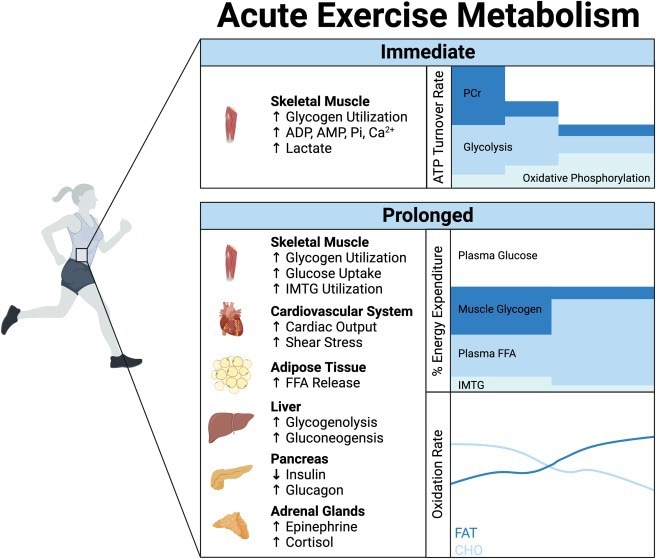Exercise Health Benefits
Studies indicate that individuals who exercise regularly and achieve the recommended levels of physical activity are at a lower risk of a wide range of diseases, including diabetes, cardiovascular disease, various types of cancer, and all-cause mortality. Current health recommendations suggest about 150 to 300 minutes of moderately intense exercise or 75 to 150 minutes of vigorous exercise, such as running per week for adults. Furthermore, the ideal exercise routine should consist of muscle strengthening and activities to improve balance and endurance.
While factors such as resistance, number of sets, rest intervals, and repetitions can be modulated, the general principle of exercise regimens is progressive overload, where the load is increased progressively to improve the adaptive response. The subsequent increase in energy demand also results in changes in systemic metabolic homeostasis. The review examined the adaptive changes that occur in various tissues in response to chronic exercise. The review focused on resistance and endurance exercises with studies involving human interventions.
Energy Demands and Metabolic Responses to Exercise
Exercise generates intense energy demands, with almost a 100-fold increase in the requirement of adenosine triphosphate (ATP) supplied through the activation of both aerobic and anaerobic pathways. Short but intense exercise results in an increased utilization of the anaerobic pathways and glycogen stores. However, longer exercise durations depend on aerobic ATP production metabolisms, resulting in increased oxygen consumption, redistribution of blood flow into muscles, and cardiac output.
Furthermore, various signal transduction pathway networks and transcriptional programs that respond to muscle contractions, availability of energy, hormones, ions, oxygen availability, and redox state are activated during acute exercise. Transcriptional programs are activated by acute exercise in a tissue-specific manner through the involvement of various transcriptional factors, corepressors, and coactivators.
Role of Exerkines in Exercise Response
The review also discussed exerkines — a term coined to define the signaling molecules induced by exercise that have an impact on various tissues through autocrine, paracrine, and endocrine pathways. Exerkines include proteins such as cytokines, lipids, peptides, metabolites, and various types of nucleic acids such as mitochondrial ribonucleic acid (mRNA), micro-RNA, and mitochondrial deoxyribonucleic acid (DNA). The studies examined in the review discussed exerkines and their impact on various tissues and organs, including muscles, brain, liver, heart, gut, adipose tissue, and pancreas.
Interleukin-6 (IL-6) was the most extensively studied exerkine, and the researchers discussed the secretion of IL-6, as well as the metabolic effects of IL-6 on processes such as lipolysis of adipose tissue, glucose uptake in resting skeletal muscles, exercise-related glucose metabolisms, and various other processes.

Multi-tissue coordination of acute exercise metabolism
Adaptations Across Various Body Systems
The review also explored various adaptations that occur as a result of chronic exercise and affect skeletal muscles, the cardiovascular system, the pancreas, the brain, gut, and adipose tissue. Some of the adaptations associated with cardiovascular fitness that were discussed included those linked to increases in maximal oxygen consumption, such as higher hemoglobin mass, red cell volume, and cardiac output. Additionally, adaptations such as increased mitochondrial function and capillary density that occur inside the musculature were also discussed.
Other adaptations included in the review were the enlargement and remodeling of the heart after long-term intense exercise and alterations to the peripheral vasculature. The review also covered the variations in patterns of cardiac hypertrophy based on whether the exercise training consisted of more endurance or resistance training.
Adaptations associated with the skeletal muscles included increased aerobic energy production capacity, carbohydrate oxidation capacity, and higher mitochondrial biogenesis. Higher force-generating capacity, an increase in the cross-sectional area of muscle fibers through myofibrillar protein accretion, and a greater capacity to non-oxidatively produce energy were some of the other adaptations in the skeletal muscles linked to resistance exercises.
The review also extensively discussed adaptations to resistance and endurance exercise in the adipose tissue metabolism, hepatic function, and pancreatic metabolism involving β cells. Changes in gut microbiota and brain function due to chronic exercise and their impacts on overall health and lowering the risk of various diseases were also examined in the review.
Concluding Insights
Overall, the review comprehensively summarized the current knowledge about various types of chronic exercise regimens, such as endurance and resistance training, and the physiological and biochemical adaptations to exercise training that contribute to improvements in health and the lowering of disease risk.